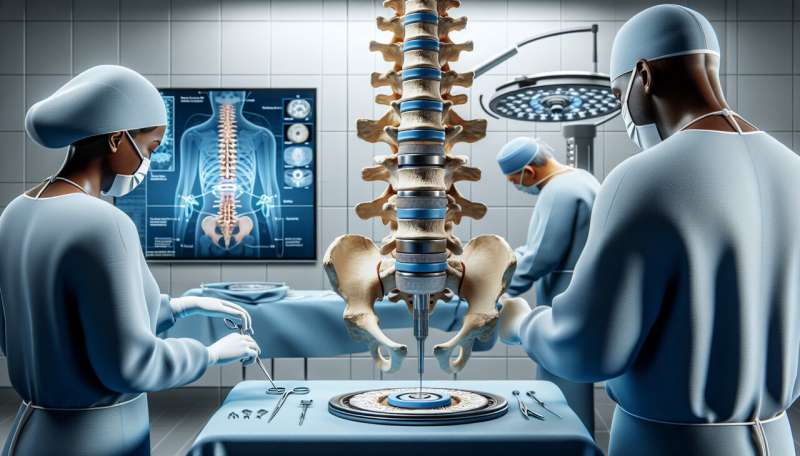by Giovanni E Ferreira, Christine Lin, Christopher Maher, Ian Harris and Joshua Zadro, The Conversation

Last week in a post on X, owner of the platform Elon Musk recommended people look into disk replacement if they’re experiencing severe neck or back pain.
According to a biography of the billionaire, he’s had chronic back and neck pain since he tried to “judo throw” a 350-pound sumo wrestler in 2013 at a Japanese-themed party for his 42nd birthday, and blew out a disk at the base of his neck.
In comments following the post, Musk said the surgery was a “gamechanger” and reduced his pain significantly.
Musk’s original post has so far had more than 50 million views and generated controversy. So what is disk replacement surgery and what does the evidence tells us about its benefits and harms?
What’s involved in a disk replacement?
Disk replacement is a type of surgery in which one or more spinal disks (a cushion between the spine bones, also known as vertebrae) are removed and replaced with an artificial disk to retain movement between the vertebrae. Artificial disks are made of metal or a combination of metal and plastic.
Disk replacement may be performed for a number of reasons, including slipped disks in the neck, as appears to be the case for Musk.
Disk replacement is major surgery. It requires general anesthesia, and the operation usually takes 2–4 hours. Most people stay in hospital for 2–7 days. After surgery patients can walk but need to avoid things like strenuous exercise and driving for 3–6 weeks. People may be required to wear a neck collar (following neck surgery) or a back brace (following back surgery) for about 6 weeks.
Costs vary depending on whether you have surgery in the public or private health system, if you have private health insurance, and your level of coverage if you do. In Australia, even if you have health insurance, a disk replacement surgery may leave you more than A$12,000 out of pocket.
Disk replacement surgery is not performed as much as other spinal surgeries (for example, spinal fusion) but its use is increasing.
In New South Wales for example, rates of privately-funded disk replacement increased six-fold from 6.2 per million people in 2010–11 to 38.4 per million in 2019–20.
What are the benefits and harms?
People considering surgery will typically weigh that option against not having surgery. But there has been very little research comparing disk replacement surgery with non-surgical treatments.
Clinical trials are the best way to determine if a treatment is effective. You first want to show that a new treatment is better than doing nothing before you start comparisons with other treatments. For surgical procedures, the next step might be to compare the procedure to non-surgical alternatives.
Unfortunately, these crucial first research steps have largely been skipped for disk replacement surgery for both neck and back pain. As a result, there’s a great deal of uncertainty about the treatment.
There are no clinical trials we know of investigating whether disk replacement is effective for neck pain compared to nothing or compared to non-surgical treatments.
For low back pain, the only clinical trial that has been conducted to our knowledge comparing disk replacement to a non-surgical alternative found disk replacement surgery was slightly more effective than an intensive rehabilitation program after two years and eight years.
Complications are not uncommon, and can include disclocation of the artificial disk, fracture (break) of the artificial disk, and infection.
In the clinical trial mentioned above, 26 of the 77 surgical patients had a complication within two years of follow up, including one person who underwent revision surgery that damaged an artery leading to a leg needing to be amputated. Revision surgery means a re-do to the primary surgery if something needs fixing.
Are there effective alternatives?
The first thing to consider is whether you need surgery. Seeking a second opinion may help you feel more informed about your options.
Many surgeons see disk replacement as an alternative to spinal fusion, and this choice is often presented to patients. Indeed, the research evidence used to support disk replacement mainly comes from studies that compare disk replacement to spinal fusion. These studies show people with neck pain may recover and return to work faster after disk replacement compared to spinal fusion and that people with back pain may get slightly better pain relief with disk replacement than with spinal fusion.
However, spinal fusion is similarly not well supported by evidence comparing it to non-surgical alternatives and, like disk replacement, it’s also expensive and associated with considerable risks of harm.
Fortunately for patients, there are new, non-surgical treatments for neck and back pain that evidence is showing are effective—and are far cheaper than surgery. These include treatments that address both physical and psychological factors that contribute to a person’s pain, such as cognitive functional therapy.
While Musk reported a good immediate outcome with disk replacement surgery, given the evidence—or lack thereof—we advise caution when considering this surgery. And if you’re presented with the choice between disk replacement and spinal fusion, you might want to consider a third alternative: not having surgery at all.
This article is republished from The Conversation under a Creative Commons license. Read the original article.![]()
Citation:
Elon Musk says ‘disk replacement’ worked for him. But evidence this surgery helps chronic pain is lacking (2024, April 23)
elon-musk-disk-evidence-surgery.html
.
. The content is provided for information purposes only.
